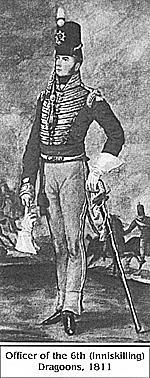 During the Napoleonic Wars the land forces of the Crown
comprised a number of sometimes quite disparate elements, and
although this article is concerned with the greatest of them, the
British Army itself, it is as well to begin by outlining all of them
and briefly describing their status and relationship.
During the Napoleonic Wars the land forces of the Crown
comprised a number of sometimes quite disparate elements, and
although this article is concerned with the greatest of them, the
British Army itself, it is as well to begin by outlining all of them
and briefly describing their status and relationship.
The British Army proper comprised General and Staff officers, the Household regiments of cavalry and infantry, and the cavalry and infantry of the line. Closely bound up with them, but constitutionally separate were those troops administered by the Board of Ordnance the most important of whom were of course the officers and men of the Royal Artillery. Although their rank structure, responsibilities and promotion system differed in some measure there was complete equality between the two services.
This was not always the case with the third of the services; the
armies of the East India Company. While they had come into being
as the mercenary servants of a trading company, the fact of the
matter was that by the 1790s the Company was being run by the
British Government through the Board of Control, rather than by
the ordinary shareholders. In 1795-96 its officers successfully
resisted assimilation into the British Army [1]
while at the same time
winning local brevets which placed them on something approaching
an equal footing with regular officers. Consequently their de facto
position, particularly after recruitment for the European regiments
was placed on a regular footing in 1799, became similar to that of
Ordnance officers; in that they were administratively separate but
operationally fully integrated.
Of much lesser importance were the Militia and
Volunteers, both of the whom were administered by e ome Office.
Operationally they came under Army command but unlike
Ordnance and EIC officers they certainly did not enjoy equal status.
More Officers and Gentlemen Part I
Officers and Gentlemen Part II
Part I: Introduction
Part I: Regimental Officer Structure
Part I: Surgeon, Chaplain
Part I: Quartermaster, Paymaster, Adjutant, Agent
Part I: Staff Officers
Back to Age of Napoleon 30 Table of Contents
Back to Age of Napoleon List of Issues
Back to MagWeb Master List of Magazines
© Copyright 1999 by Partizan Press.
This article appears in MagWeb (Magazine Web) on the Internet World Wide Web.
Other military history articles and gaming articles are available at http://www.magweb.com